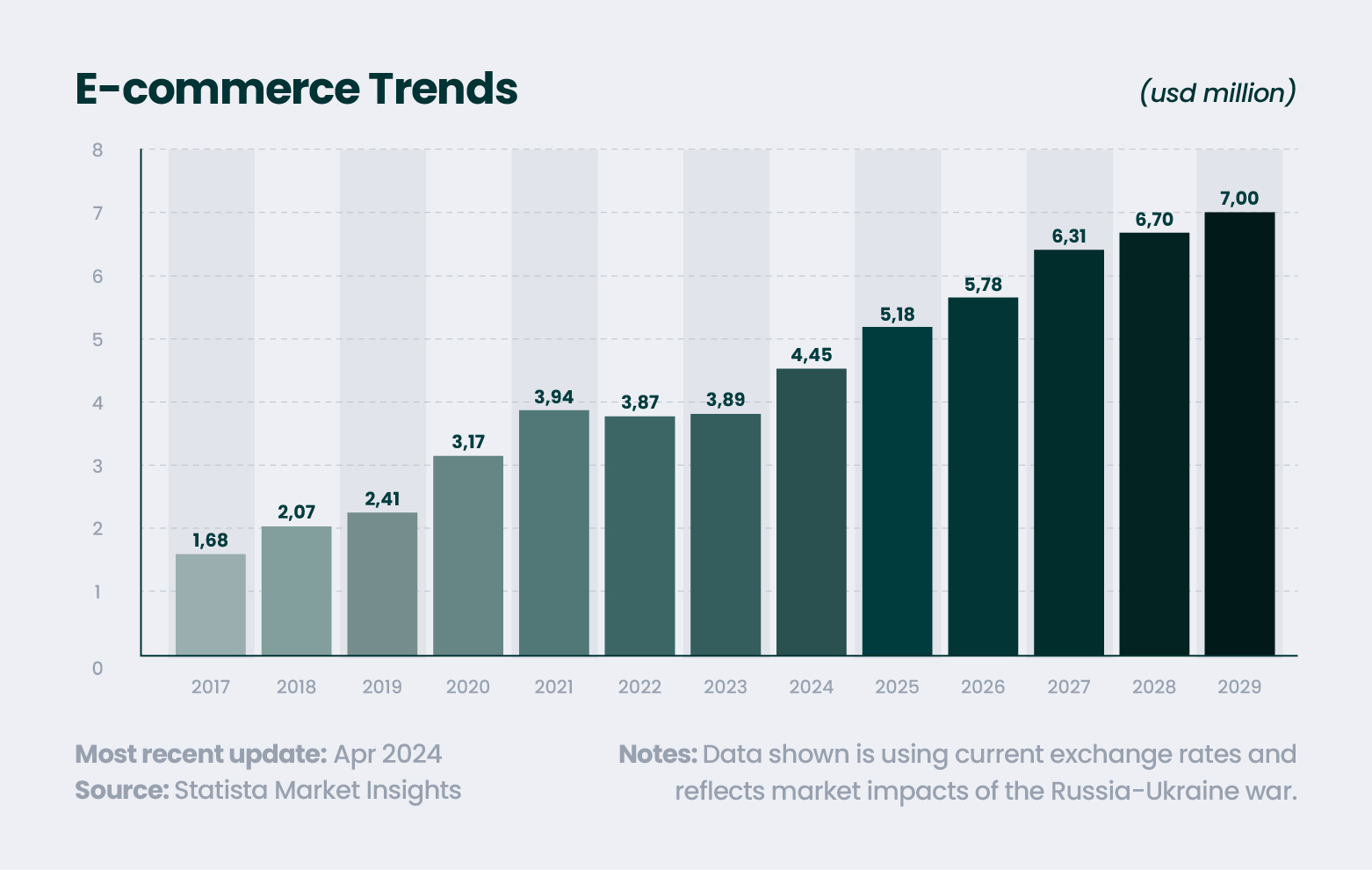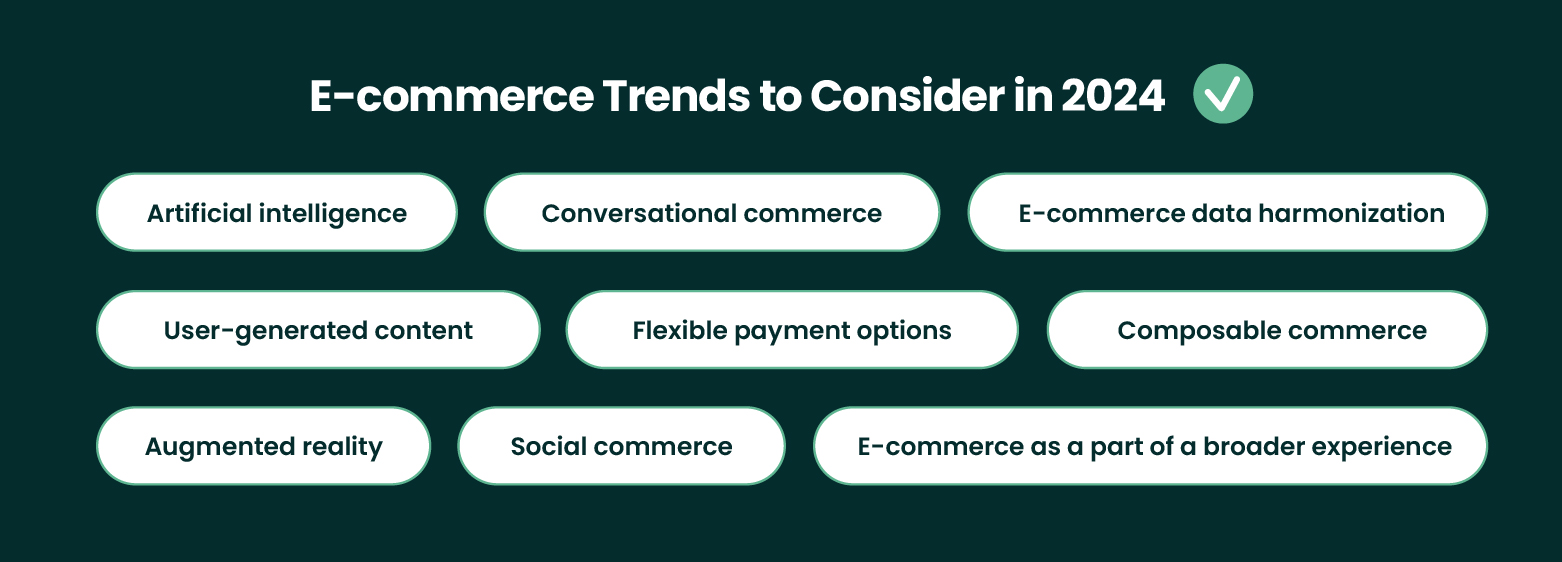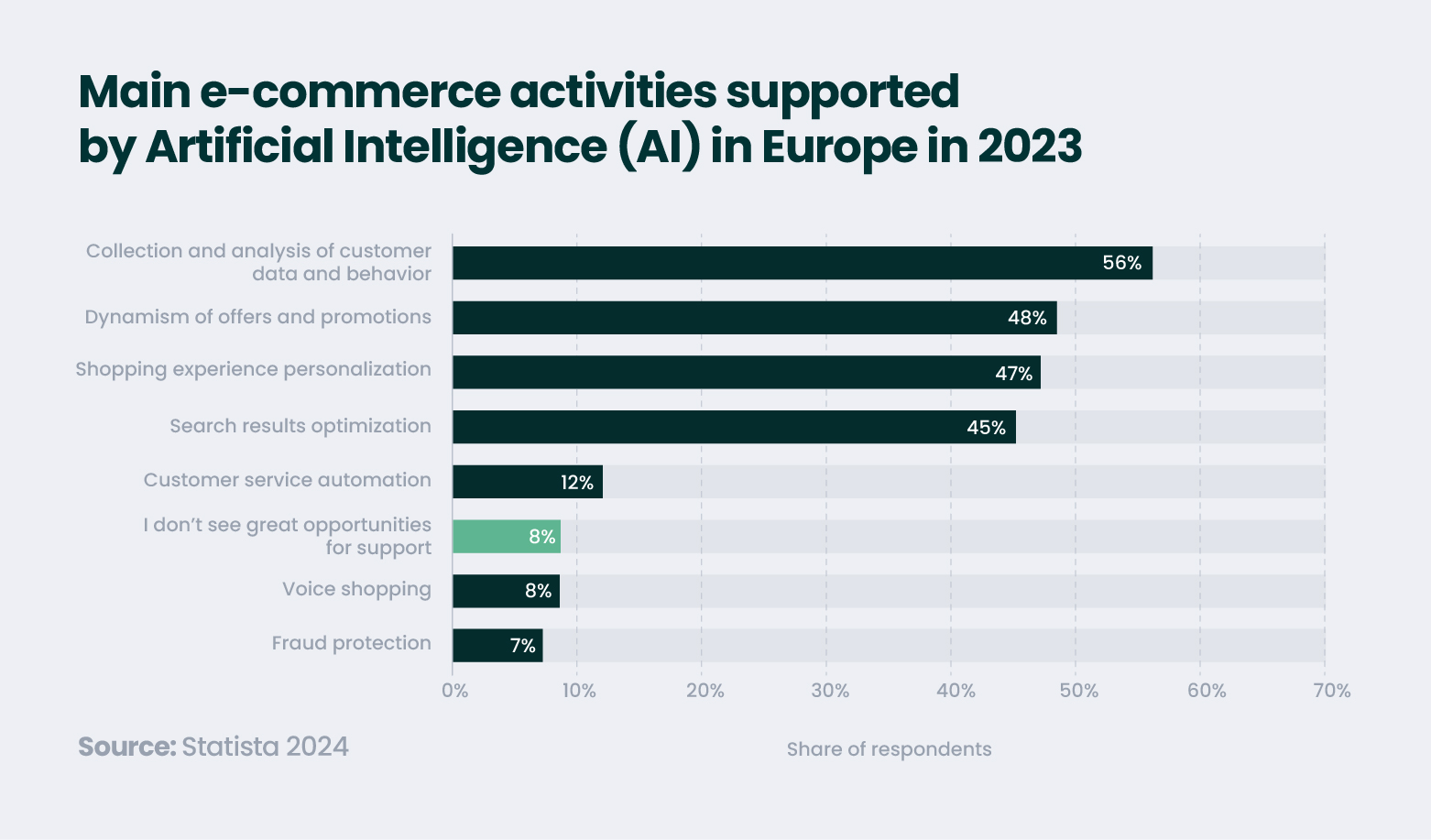The future of e-commerce is uncertain. Retailers are looking for new opportunities and rethinking their approaches to online business. Why is that happening?
First, we feel global inflation pressures that restrain business capacity to expand and affect potential customer decisions. Even the top e-commerce brands aren’t immune to these challenges and experience difficulties in advancing their growth.
Second, the costs of raw materials are increasing. And you have no other choice but to raise prices. But how to retain your regular customers and attract new ones if the worldwide crisis also influences them?
Luckily, e-commerce still has the strength to resist and use the situation in the market to bring exciting opportunities for both businesses and customers. This is happening because of the emergence of e-commerce trends that should be adopted to better respond to customer needs and fuel retail with the latest insights.
In this article, the Forbytes team will present top e-commerce trends to consider in 2024 and show how to future-proof your online store. Hopefully, this info will lead you in the right direction.
What E-commerce Hurdles Await Retailers?
Despite retailers having high hopes for e-commerce, they should be aware of the hurdles awaiting them in 2024.
First, global inflation pressures are inevitable. According to Statista, 40% of the respondents share that inflation is their leading concern. 31% believe that it will reinforce the problem of poverty and social inequality while 26% of respondents are convinced that inflation will bring unemployment.
What does it mean for retailers? Loss of regular clients, increase in prices, work in tough conditions, but that’s not all.
Second, e-commerce companies attached to the North American and European markets can lag behind those that operate in China. The International Trade Association reports that China leads in global e-commerce sales, accounting for more than 50% of all global retail sales.
It means that retailers should either change their geographic focus or look for new ways to advance their tech growth to ensure a bright future for e-commerce.
Fortunately, online stores can manage these challenges in the following ways:
- Expanding their reach across channels to increase their customer base and revenue streams.
- Using customer data and analytics to fine-tune marketing strategies and boost ROI.
- Staying flexible and responding swiftly to changing trends in e-commerce shopping to remain competitive.
With these strategies in mind, let’s reveal key e-commerce trends that will fuel your company with tech solutions to help advance growth. Plus, they will make you immune from issues in the global market.
Which E-commerce Trends to Adopt in 2024?
According to Statista, by 2029, revenue in the e-commerce market is projected to reach $7 trillion with an annual growth rate of 9, 48%. The number of users is expected to reach 3,5 billion, and user penetration will hit 48,3%. So see, the e-commerce market will grow significantly, offering more opportunities for online stores.

To stay ahead of the curve and remain competitive, it is a must for your e-commerce company to show dynamics and readiness to transform the way you conduct your business. In 2024, the following emerging online shopping trends will reshape the nature of e-commerce and bring more benefits to customers.
We’ll focus on those that are worth keeping an eye on and taking advantage of them.

AI as an instrument for a highly personalized experience
No doubt, today, artificial intelligence is more than an e-commerce trend, this is an instrument used by online stores to offer highly tailored experiences. From recommended products and voice search to chatbots for 24/7 support, AI in e-commerce works for quality service and exceptional customer experience.
For example, in 2023, 56% of e-commerce professionals from Europe reported that artificial intelligence could support many e-commerce activities from collection and analysis of customer data and behavior to AI-powered customer support and dynamic pricing. So, AI algorithms do more than recommend products; they analyze large volumes of consumer data to reveal their preferences and create customized shopping experiences.

Conversational commerce for better connection with customers
According to Forbes, 86% of consumers are ready to pay more for a better customer experience, implying that not all online stores offer quality services. But how to ensure a better connection with clients and stay on the same wavelength?
Conversational commerce is an online shopping trend that is on the way to help. It is also known as conversational marketing or chat commerce. This approach to e-commerce is used by online retailers to sell their products and services with the help of conversation.
A chat app, chatbot, voice assistant, and messaging platform are tools to deliver a conversational experience. As long as your talk with a client is personalized, conversational commerce serves its purpose.
According to InsightAce Analytics, the global conversational commerce market size was valued at 6,85 billion in 2023. But it is projected to reach 20,78 billion by 2031 with an annual growth of 15,1%. Conversational commerce is picking up steam, allowing online stores to compensate for the lack of physical and personal touch with their clients.
E-commerce data harmonization for more business insights
Data harmonization means bringing together different types of data into one dataset. Within a company, users should have easy access to high-quality data in agreed-upon formats. Data harmonization boosts data value and use. It helps organizations turn messy data into usable insights, cutting down on time spent finding information and reducing costs.
With data harmonization, you’ll gather more insights from various areas like consumer research or market performance. Plus, by having more structured and organized data, you’ll get to know what areas to optimize and how to get more from your data.
UGC for an engaging customer experience
User-generated content (UGC) is another trend in e-commerce used to create an emotional bond with clients. As a rule, this is any form of content created by a company’s customer. From social media posts and videos to images and textual reviews, these are diverse forms of interaction between a brand and its audience.
This customer-centric approach is valuable because it serves as a source of social proof for customers. Reasonably, 65% of brands believe that UGC helps them increase trust in their products and connect with their customers. User-generated content helps online stores improve the shopping experience, make e-commerce campaigns more personal, and increase brand awareness.
Flexible payment options for higher customer satisfaction
Flexible payment options done in one click are always trendy in e-commerce. Whether it’s a credit card, digital wallet, or other alternative payment methods, providing a choice to clients is a way to cater to their diverse preferences. If customers are satisfied and make their purchases effortlessly, they can become regular ones.
Digital payments, including Apple Pay, PayPal, and Alipay are the fastest-growing payment methods worldwide. The annual growth rate of such digital wallet transactions is estimated to be 15% between 2023 and 2027. It means that payment in one click has arisen from another e-commerce trend like shopping on smartphones or mobile commerce.
Composable commerce for serving customers’ needs
E-commerce is an evolving and changing area, and clients expect even more transformations and new solutions from online stores. Composable commerce is an approach to e-commerce where businesses build their digital commerce infrastructure with the help of modular components. As a result, using these interchangeable modules, enterprises can construct their digital commerce infrastructure and achieve greater scalability and adaptability.
Composable commerce offers many benefits to business-enhancing e-commerce. Here are a few ways this e-commerce trend can ensure greater flexibility.
First, composable commerce helps businesses stay flexible by breaking systems into smaller components that can be easily modified, improved, and scaled. This means they can quickly adjust to changes in the market and technology and stay ahead in innovation. Second, this modular approach lets businesses grow smoothly. They can handle performance drops and add new features whenever they need to.
So, composable commerce is a transformative solution, making systems more scalable, flexible, and efficient.
Augmented reality (AR) for transforming product visualization
Say goodbye to boring and lifeless product images and revitalize your product portfolio with augmented reality. Augmented reality is an e-commerce trend that blurs the line between online shopping and hands-on experience. For example, if you intend to buy a car, you can open the door, peer under the hood, or even take a test drive without leaving your laptop.
The magic of AR goes beyond mere visualization, allowing customers not only to find clothes but also to try them and be sure that they fit them perfectly. Plus, you can easily customize materials and colors in real time. As a result, such involvement fosters clients’ confidence and trust in online shopping.
Social commerce for engaging audiences
Social media in retail is more than just an e-commerce trend. Social media platforms like Instagram and TikTok are full of online stores that create compelling content to influence the audience’s purchasing decisions. The social media world is fluid, spontaneous, and efficient in reaching potential clients.
Live video shopping sessions have become an interactive way for brands to showcase products in real time, engage viewers, and answer their questions. As a result, the lines between e-commerce and entertainment are blurring, resulting in an interactive experience that increases both engagement and sales at the same time.
E-commerce as a part of a broader experience
Nowadays, e-commerce tends to penetrate other industries, allowing businesses to expand their service line and increase ROI. In addition to their core services, companies also offer products for sale. For example, you may be familiar with a situation where you book a hairstyling appointment online. And the beauty salon offers to buy hair essentials directly on its website.
Here’s one more instance: you enroll in an educational online course and can purchase books and learning materials in a few clicks, without leaving the edtech company’s site. These are examples of how professional services companies integrate e-commerce into their digital context, opening new revenue opportunities and providing their clients with more comprehensive experiences.
At Forbytes, we also have the on-point story demonstrating how businesses operating in other industries can use the power of e-commerce to maximize their outputs. Our client, Sharkmob, a top-tier game development company, designed a full-scale in-game store where game players can purchase items to customize their characters and improve their capabilities.
Sharkmob needed aid in building a store management system and integrating it with the in-game store and the game as a whole. Our software engineers completed the task. With the help of the custom-built system Forbytes developed for the client, Sharkmob managers can keep track of the in-game purchases made by players, organize and structure game season sales, manage store assortment, view analytics, and more.
The system is one of the examples of how the e-commerce experience goes beyond retailing, being integrated into the broader context. Not only did Sharkmob add the store to their game experience, but they also created a custom management system enabling effective e-commerce operations under the hood.
Contact us if you also aim to add e-commerce offerings to your service line to boost your sales and company’s impact. Our expert team knows how to ensure a flawless e-commerce experience at any stage of the supply chain, from back-office managers to customers engaging with the UI part of the system.
How to Future-Proof Your E-Commerce Business
With the help of the e-commerce trends mentioned above, you can future-proof your store. Here are a few more tips on how to stay ahead of the curve:
- Get Your Data Right: Make sure your data is well-structured, accurate, and accessible across all channels. This helps you make more informed decisions and personalize customer experiences.
- Embrace Tech: Keep up with the latest technology to improve efficiency, scalability, and customer engagement. AI and AR can work best for you.
- Go Beyond Sales: Offer more than just products. Focus on building emotional bonds with your audience, offering great support, and creating engaging experiences to keep customers coming back.
With these strategies and e-commerce trends, you can ensure your online store stays efficient in a constantly changing digital world.
Need Help With Upgrading Your E-Commerce with the Latest Tech Trends?
Looking to build an e-commerce platform or upgrade an existing online store with top tech trends? Trust this matter to the Forbytes Team. Having more than 13 years of expertise in e-commerce and a talented team, we can share this journey with you and facilitate your growth.
At Forbytes, we offer e-commerce website development services for both B2B and B2C businesses. Whether you need a customized e-commerce system, we have you covered. Just contact us, and we’re always at your service.

Our Engineers
Can Help
Are you ready to discover all benefits of running a business in the digital era?

Our Engineers
Can Help
Are you ready to discover all benefits of running a business in the digital era?










